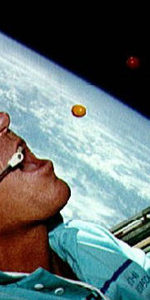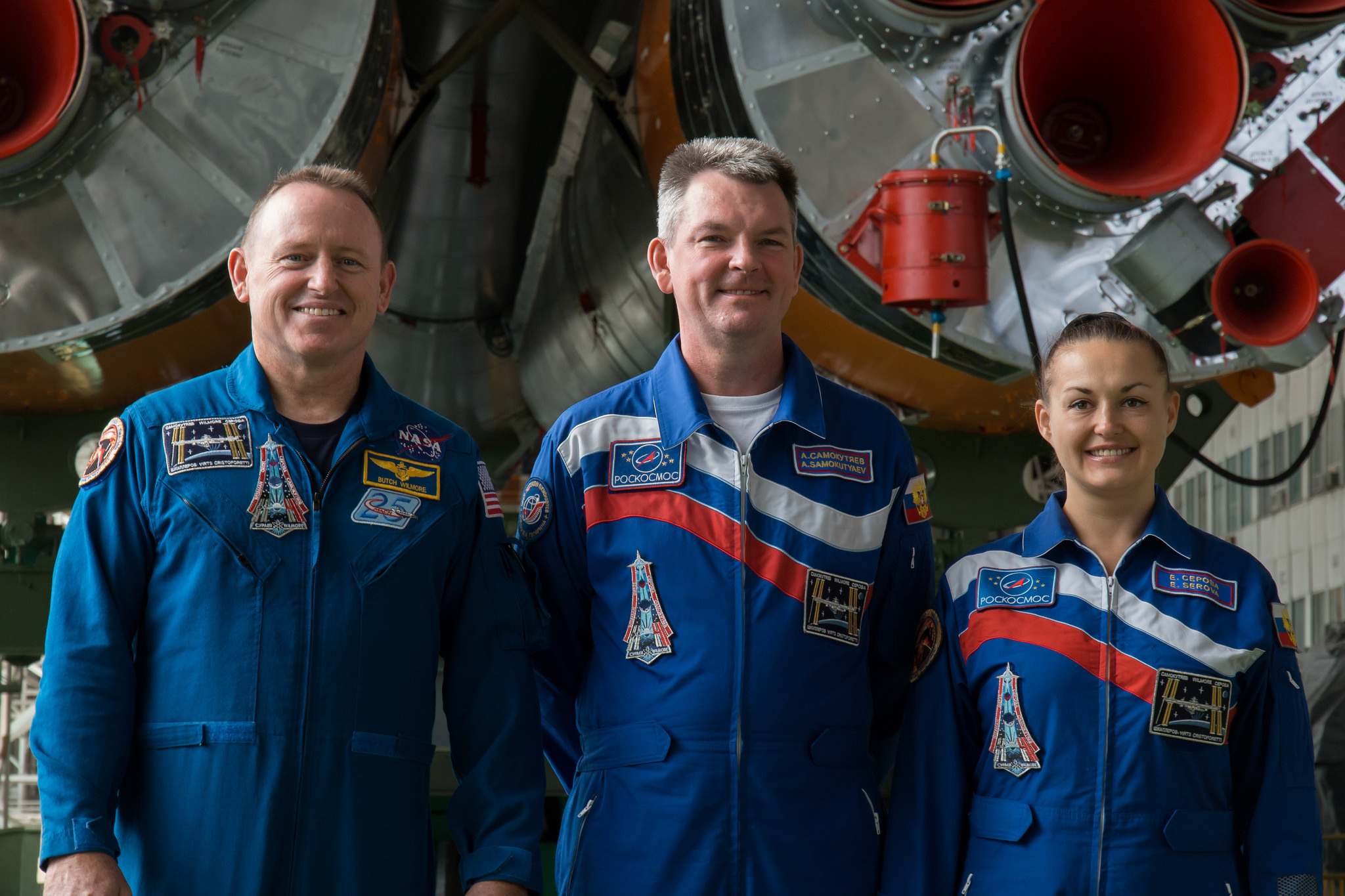
Two weeks after the 10 September return to Earth of Soyuz TMA-12M, a new three-member crew is scheduled to launch toward the International Space Station (ISS) to continue its permanent occupancy through March 2015. Liftoff of Soyuz TMA-14M is targeted to occur from Baikonur Cosmodrome’s historic Site 1/5—the same location from which Yuri Gagarin began his historic mission, more than 53 years ago—in Kazakhstan at 2:25 a.m. local time Friday, 26 September (4:25 p.m. EDT Thursday, 25 September). It will deliver Russian cosmonauts Aleksandr Samokutyayev and Yelena Serova, together with U.S. astronaut Barry “Butch” Wilmore on a six-hour, four-orbit “fast rendezvous” profile to dock with the space-facing (or “zenith”) Poisk module at 8:16 a.m. Baikonur time Friday (10:16 p.m. EDT Thursday). They will join the incumbent Expedition 41 crew of Russian cosmonaut Maksim Surayev, U.S. astronaut Reid Wiseman and Germany’s Alexander Gerst, who have been aboard the ISS since late May.
The Soyuz TMA-14M spacecraft comprises three main segments—from the base, a cylindrical instrument and propulsion module, a bell-shaped descent module, and a spheroidal orbital module—which arrived at Baikonur on 26 May to commence pre-flight inspections, firstly in the Spacecraft Assembly and Testing Facility and subsequently, in late August, in the vacuum chamber for leak checks and radio interference testing. It was loaded with approximately 1,760 pounds (800 kg) of unsymmetrical dimethyl hydrazine and nitrogen tetroxide propellants for its propulsion system, together with helium pressurant and oxygen and nitrogen gases for the environmental control systems.
On 13 September, a meeting of the Technical Management authorized the loading of Soyuz TMA-14M with propellants and compressed gases and, two days later, the spacecraft returned to the Spacecraft Assembly and Testing Facility for final processing. Several days later, it was encapsulated within its payload shroud, ahead of the scheduled installation atop the Soyuz-FG booster and the State Commission met on Monday, 22 September, to review the status of the mission. Approval to proceed was granted and the vehicle—emblazoned with advertisements for the 16th FINA World Aquatics Championships, to be held in Kazan next summer—was cleared for rollout to Site 1/5.
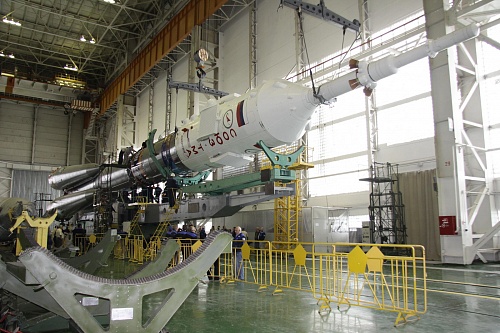
In the meantime, on 28 August the Soyuz TMA-14M prime crew and their backups—Russian cosmonauts Gennadi Padalka and Mikhail Kornienko, together with U.S. astronaut Scott Kelly—participated in a “typical flight day” in the simulator of the Russian Orbital Segment (ROS) of the ISS to test their ability to respond to standard and non-standard situations. Final qualification exams commenced in the first week of September, with both crews achieving perfect scores from the examiners.
On 12 September, the crews flew into Baikonur for the final two weeks of training, with the Samokutyayev, Serova, Padalka, and Kornienko clad in suits and the U.S. astronauts—both of whom are active-duty U.S. Navy officers—clad in their Service Dress Whites (Wilmore) and Service Dress Blues (Kelly). They were greeted by members of the State Commission and Technical Management, to whom Samokutyayev and Padalka declared their training readiness and their acceptance of the Soyuz TMA-14M spacecraft. Although the arrival at Baikonur offered a measure of time for relaxation, the two crews plunged directly into a final training phase aboard the spacecraft itself, utilizing laser range-finders and acquainting themselves with on-board documentation and performing fit-checks of their Sokol (“Falcon”) launch and entry suits and individualized seat liners. They also took part in customary flag-raising and tree-planting ceremonies.
With liftoff of Soyuz TMA-14M targeted for early Friday, local time (late Thursday afternoon, EDT), Launch Day promises to be a long one for Samokutyayev, Serova, and Wilmore. Since March 2013, Russia has endeavored to deliver Soyuz crews to the station in just six hours, and four orbits of Earth, in order to alleviate pressure on the crew. Previous missions had typically followed two-day-long rendezvous profiles, which were more economical in terms of propellant expenditure, but which also tended to be highly cramped, stressful, and exacerbated nausea and motion sickness for the crew. Although hugely complex, a process was developed to get them to the ISS more quickly.
First trialed by an unmanned Progress resupply craft in August 2012, the six-hour, four-orbit rendezvous was successfully executed by four Soyuz crews last year and would have been performed by Soyuz TMA-12M in March, but for a malfunction shortly after orbital insertion. This forced the crew to revert to the standard two-day, 34-orbit approach profile, which was completed successfully. “Same-day” rendezvous and docking are nothing new. In September 1966, Gemini XI astronauts Charles “Pete” Conrad and Dick Gordon accomplished a rendezvous and docking with an Agena target vehicle just 85 minutes and a single orbit after launch. Several years later, during the Skylab era, crews followed an expedited rendezvous lasting eight or nine hours to reach their home in space. However, since the late 1970s, in the interests of propellant economy, most crews—including shuttle-Mir and ISS crews—have spent between one and two days in transit, prior to docking.
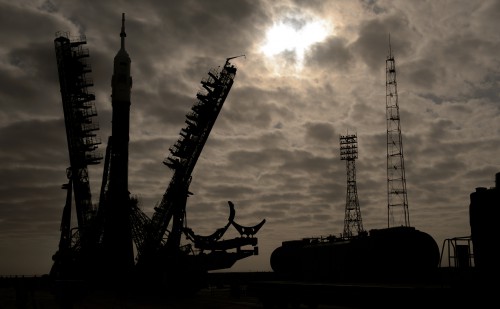
About four hours ahead of launch, Samokutyayev, Serova, and Wilmore will be helped into their Sokol launch and entry suits and should be ensconced in their specially-contoured seats aboard the Soyuz TMA-14M descent module at the pad about two hours later. In command of the spacecraft will be Samokutyayev, positioned in the center seat, with Serova to his left and Wilmore to his right. In those final hours, their launch vehicle—a descendent of Sergei Korolev’s R-7 rocket, an early version of which carried Yuri Gagarin into space—will undergo final checks, culminating in the conclusion of fueling and the implementation of the flight program software. Ten minutes before launch, the three men will be instructed to close their visors. A minute before liftoff, the rocket will transition to internal power and at T-10 seconds the engine turbopumps will attain full speed. By five seconds, the engines themselves will reach maximum thrust, leading to the retraction of the launch pad’s fueling tower and an on-time liftoff into the darkened Baikonur sky at 2:25 a.m. local time Friday, 26 September (4:25 p.m. EDT Thursday, 25 September). This will kick off the second half of Expedition 41.
Within a minute of clearing the tower, the rocket will be traveling at more than 1,100 mph (1,770 km/h), and at T+118 seconds the four tapering strap-on boosters will be jettisoned, leaving the core stage alone to complete the push into low-Earth orbit. By the two-minute mark, Samokutyayev, Serova, and Wilmore will surpass 3,350 mph (5,390 km/h), and, shortly thereafter, the escape tower and launch shroud will separate, exposing Soyuz TMA-14M to vacuum for the first time. Four minutes and 58 seconds after leaving the desolate steppe of Central Asia, the core booster will separate at an altitude of 105.6 statute miles (170 km) and the third and final stage will ignite, boosting the Soyuz to a velocity of more than 13,420 mph (21,600 km/h). By the time the third stage separates, nine minutes into the flight, Samokutyayev, Serova, and Wilmore will enter an orbit of about 124 x 163 miles (199 x 262 km), inclined 51.6 degrees to the equator and can begin the process of deploying their craft’s communications and navigation antennas and solar arrays.
Four maneuvering “burns” will be required to raise the apogee of their orbit to reach the ISS operational altitude. The first burn (DV-1) should take place 45 minutes into the mission, followed by the second burn (DV-2), which is timed to occur 90 minutes after launch. These will be followed by a second pair of burns, later in the rendezvous sequence, which should position Soyuz TMA-14M for an on-time docking at the station’s space-facing (or “zenith”) Poisk module at 8:16 a.m. Baikonur time Friday (10:16 p.m. EDT Thursday), about five hours and 51 minutes after liftoff.
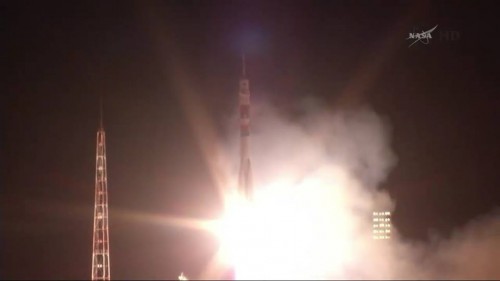
Following standard pressure and leak checks, the hatches will be opened and the new arrivals will be greeted by the incumbent Expedition 41 crew of Russian cosmonaut Maksim Surayev, U.S. astronaut Reid Wiseman, and Germany’s Alexander Gerst, who have been in orbit since 28 May. At the time of the Soyuz TMA-14M docking, the space station will accommodate a number of other uncrewed visiting vehicles: Russia’s Progress M-24M, which has been in place at the nadir port of the Pirs module since late July, Europe’s fifth and final Automated Transfer Vehicle (ATV-5), which has been attached to the Zvezda service module’s aft longitudinal port since August and SpaceX’s fourth dedicated Dragon cargo mission (CRS-4), which was launched successfully on Sunday, 21 September, and is due to be berthed at the nadir port of the Harmony node early Tuesday.
Interestingly, as described in AmericaSpace’s CRS-4 preview article, the Dragon mission will transport two critical Long Life Batteries (LLBs) to the space station for the U.S. Extravehicular Mobility Unit (EMU) space suits. Another pair of batteries will also be carried aboard Soyuz TMA-14M itself, enabling Expedition 41 crewmen Wiseman, Gerst, and Wilmore to conduct a pair of EVAs in October. These spacewalks were originally planned for August, but were deferred when a failure was discovered in one of the lithium-ion LLBs already aboard the ISS. “All electrical parts in the life-support system … are burned-in,” explained AmericaSpace Editor Jim Hillhouse. “Since all LLB fuses use the same burn-in procedure and test setup, the concern was that other long-life batteries could have the same problem. In early August, the [Expedition 40] crew began removing the LLBs from the on-board EMUs to be returned to the ground.”
Current planning envisages that the first EVA will involve Wiseman and Gerst and will occur no sooner than 7 October. Although both astronauts have been in orbit for four months of a planned 5.5-month expedition, both are currently on the first space missions and neither has previously performed a spacewalk. Consequently, this will be the first occasion since September 2008—and the inaugural Chinese EVA by crewmen Zhai Zhigang and Liu Boming—that a pair of first-time spacefarers have embarked together on their first career spacewalks, without a veteran comrade in attendance. From a U.S. spacewalking perspective, it has been even longer. Not since August 2007, and the opening STS-118 spacewalk by Rick Mastracchio and Dave Williams, have two first-time EVA crewmen ventured outside together. The 7 October spacewalk will also make Gerst only the third German citizen, after his fellow countrymen Thomas Reiter and Hans Schlegel, to participate in an EVA. The second spacewalk is scheduled for 15 October and will involve Wiseman and Wilmore. Having previously flown on STS-129 in November 2009, this will make Wilmore than first shuttle pilot to undertake an EVA since Ken Bowersox on Expedition Six in April 2003.
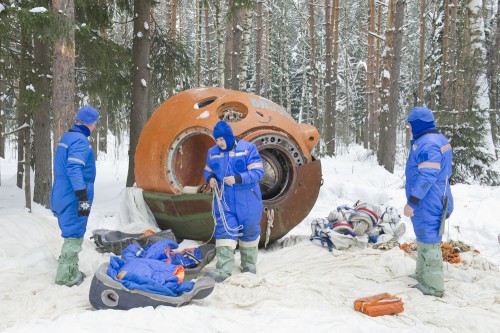
U.S. EVA plans have remained in flux since 16 July 2013, when Italian spacewalker Luca Parmitano suffered water intrusion into his helmet during EVA-23. Although a pair of contingency spacewalks were undertaken in December 2013, followed by another in April 2014, a return to normal operations had to await the results of the EVA-23 Mishap Investigation Board (MIB). In February 2014, the board described Parmitano’s water intrusion incident as a “High Visibility Close Call” and after corrective actions it was expected that the EMUs would be cleared for “standard” spacewalks in the July-August timeframe. The LLB issue postponed this resumption of operations yet further.
The Russians, meanwhile, have supported no less than three EVAs to date in 2014. A fourth is planned for 21 October, involving cosmonauts Surayev and Samokutyayev. One of their key tasks will be to install experiments onto the exterior of the Russian Segment to collect samples of space dust for analysis of microbial development.
Assuming a successful berthing of SpaceX’s CRS-4 Dragon, this cargo ship is expected to remain at the ISS until mid-October and will be robotically detached on the 18th for its return to Earth. This will be followed by the launch of the third dedicated Cygnus cargo mission (ORB-3), atop an Antares booster from Pad 0A at the Mid-Atlantic Regional Spaceport (MARS) on Wallops Island, Va. Presently scheduled to fly no earlier than 19 October, ORB-3 will continue a series of cargo delivery traffic by SpaceX and Orbital, who are both recipients of multi-billion-dollar Commercial Resupply Services (CRS) contracts from NASA. With an on-time launch, it is anticipated that the ORB-3 Cygnus should be robotically grappled by the station’s Canadarm2 robotic arm on 22 October and berthed at the Harmony nadir interface.
Unlike Dragon, however, Cygnus is not designed to be recovered after its mission. It will be loaded with trash and unneeded equipment, unberthed on 28 November, and deliberately destroyed in the upper atmosphere. Three days later, on 1 December, the fifth Dragon mission (CRS-5) will launch atop a Falcon 9 v1.1 rocket from Space Launch Complex (SLC)-40 at Cape Canaveral Air Force Station, Fla., and should berth at the Harmony nadir after about 48 hours in flight. It will remain in place until the second week of January, prior to being robotically detached and returned to Earth. Yet another Dragon (CRS-6) is tentatively planned for launch in early February 2015 and, like its predecessors, will spend about a month in residence at the ISS.
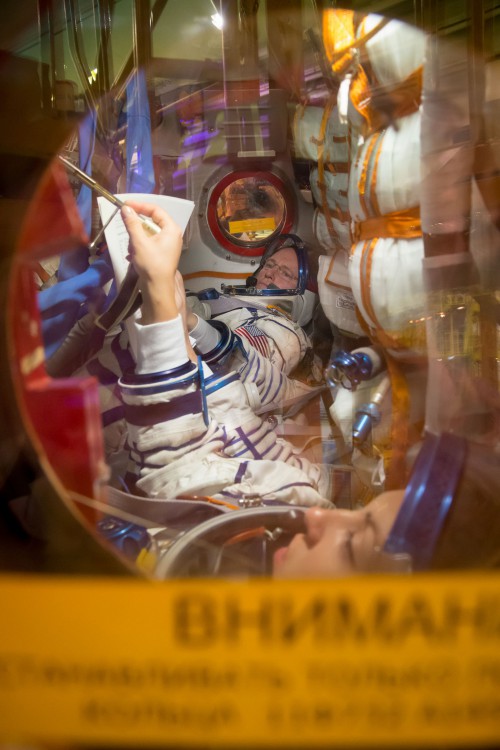
Dovetailed into these plans, Russia will also detach its Progress M-24M cargo craft from the space station on 27 October, leaving the Pirs port open for the arrival of Progress M-25M, which is due to rise from Baikonur on 29 October. Whereas Dragon and Cygnus both typically follow two-day rendezvous profiles, Progress (like Soyuz) will embark on a six-hour, four-orbit regime, docking at the ISS shortly after leaving Earth. Later, on 25 January, Europe’s ATV-5 spacecraft will depart from Zvezda’s aft longitudinal port—after almost six months in space—and be deorbited. Its place will be taken on 3 February by Progress M-26M, which will remain in place until August.
In addition to the unpiloted ISS operations, a change of crew members is currently planned for November, with the Soyuz TMA-13M team of Surayev, Wiseman, and Gerst expected to depart on the 10th after 166 days in orbit and the new Russian-U.S.-Italian trio of Anton Shkaplerov, Terry Virts, and Samantha Cristoforetti scheduled to launch from Baikonur and arrive aboard Soyuz TMA-15M on the 24th. Both spacecraft will depart from and arrive at the station’s Earth-facing (or “nadir”) Rassvet module.
With the departure of Soyuz TMA-13M, command of the ISS will pass to Wilmore, who will lead the new Expedition 42 from November until March 2015. Together with Samokutyayev and Serova, he will function for two weeks as a three-member crew, ahead of the arrival of Shkaplerov, Virts, and Cristoforetti, the latter of whom will become Italy’s first woman in space and bring with her the first space-rated espresso coffee machine. This will expand Expedition 42 to its full, six-person strength, and, with two women aboard—Russia’s Serova and Italy’s Cristoforetti—it will mark only the second occasion on which as many as two female Expedition members have been aboard the ISS simultaneously. The first time that this happened was on Expedition 24 in the summer of 2010, involving U.S. astronauts Tracy Caldwell-Dyson and Shannon Walker.
Pushing beyond Christmas and into 2015, a pair of U.S. EVAs are planned to be conducted by Wilmore and Virts in the January-February timeframe. During a pre-flight press conference in July, Wilmore explained that he and Virts would be “the cable guys,” responsible for routing power cables, umbilicals, and utilities in readiness for the delivery and installation, later in 2015, of two ISS Docking Adapters (IDAs) aboard CRS Dragon missions to support Commercial Crew operations from 2017. Last week, Boeing and SpaceX were awarded contracts totaling $6.8 billion to develop their CST-100 and Dragon V2 vehicles to return U.S. astronauts to space from U.S. soil for the first time since the end of the shuttle era. In his recent Expedition 42/43 press conference, Virts added that another EVA task would tend to the 57.7-foot-long (17.4-meter) Canadarm2. “This arm has been there for over ten years,” he explained, “and it’s getting a little sticky, so we’re going to have to go outside and put some grease on it.”
Commanding this dynamic phase of ISS expansion and operations will be U.S. Navy Captain Barry Eugene Wilmore. Born in Murfreesboro, Tenn., on 29 December 1962, he was raised in Mount Juliet, east of Nashville, where he received his early education. “My mom told me that my first word was not Mama or Daddy. It was Why?,” he told a NASA interviewer. “I’ve always been inquisitive: what’s out there and how’s that work, those types of thoughts have always been within me.” After high school, Wilmore entered the Tennessee Technological University. “I don’t think I considered not going to college,” he told a NASA interviewer, “because, from Day One, as a small child, we were pointing towards going to college and my parents instilled that in us. They were both college graduates and they saw the importance, what they wanted for us, that a college degree could bring.”
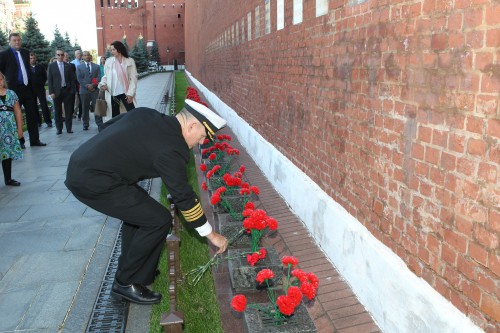
Engineering was Wilmore’s passion, but for a time he did not know what area of engineering most appealed to him. “But, secondly, I wanted to play football and I was not blessed with size or speed or strength,” he explained. “Matter of fact, I was small and slow and weak, but I had a desire and I wanted to play football and so I wanted to go to an engineering school and I wanted to play football, so I went to ’Tech.” During his undergraduate years, he was a letterman and team captain of the football team and earned a degree in electrical engineering in 1985.
With his undergraduate credential, Wilmore “had a patriotic tug … from within, to do my part for my country” and decided to enter the Navy. He hoped that his electrical engineering education would prepare him for flying jets from aircraft carriers. Wilmore entered the Navy and completed four operational deployments, flying the A-7E Corsair II and F/A-18 Hornet from the U.S.S. Forrestal, U.S.S. Kennedy, U.S.S. Enterprise, and U.S.S. Eisenhower aircraft carriers. He supported missions over Iraq during Operations Desert Storm, Desert Shield, and Southern Watch, as well as aiding U.S. and NATO interests with flights over Bosnia during the conflict in the mid-1990s. During Desert Storm, Wilmore performed no fewer than 21 combat missions from the flight deck of the Kennedy. He completed U.S. Naval Test Pilot School at Patuxent River, Md., and participated in all aspects of the initial development of the T-45 Goshawk training aircraft, which included carrier landing certification and high-angle-of-attack flight testing.
It was during a field trip at Test Pilot School that Wilmore visited NASA’s Johnson Space Center (JSC) in Houston, Texas, and was introduced to the human space program. It motivated him to pursue advanced study and in 1994 he earned two master’s degrees: one in electrical engineering from Tennessee Technical University and another in aviation systems from the University of Tennessee at Knoxville. Wilmore applied unsuccessfully for admission into NASA’s 17th astronaut intake in 1998. Following this rejection, he undertook duties at Pax River as a systems and fixed-wing Flight Test Instructor and was on exchange to the Air Force as a Flight Test Instructor at Edwards Air Force Base, Calif., when selected by NASA as a shuttle pilot candidate in the 18th astronaut class in July 2000. Interestingly, his fellow instructor Kevin Ford had also received the nod from NASA. In time, the astronaut careers of Wilmore and Ford would uncannily parallel one another: two missions, rising from the pilot’s seat of the shuttle to command of the ISS.
With more than 6,200 hours of flying time and 663 carrier landings, Wilmore spent much of his first decade as an astronaut working propulsion system issues relating to the Space Shuttle Main Engines (SSMEs), the Solid Rocket Boosters (SRBs), and the External Tank (ET). He flew his first space mission as pilot on STS-129 in November 2009, which installed a pair of External Logistics Carriers onto the ISS, and spent 11 days in orbit. Wilmore later served as Capcom during ascent and landing operations for STS-135, the final flight of the shuttle era, in July 2011. He was appointed to Expedition 41/42 in early 2012.
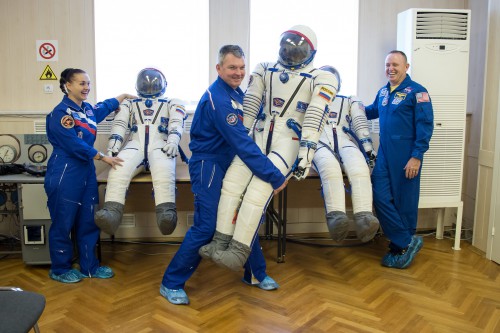
Like Wilmore, Aleksandr Mikhailovich Samokutyayev will be embarking on his second space mission aboard Soyuz TMA-14M. Unlike his U.S. crewmate, however, the retired Russian Air Force colonel has not simply visited the ISS, but has lived there, in April-September 2011, clocking up 164 days away from the Home Planet. He also performed a 6.5-hour EVA and consequently brings a great deal of experience to Expedition 41/42.
Born in the city of Penza, on the banks of the Sura River, about 390 miles (625 km) southeast of Moscow, on 13 March 1970, Samokutyayev was the son of a military father and a teacher mother. “A lot of children, when you ask them who they want to be, sometimes it’s hard for them to answer,” he told a NASA interviewer. “As long as I remember myself, it was never a difficult question for me. I always knew I was going to be a pilot.” As a boy, he built model aircraft, flew in an aircraft for the first time at the age of 16. “Once you caught the air flight bug, that’s it,” he said. “You live for the sky.”
Samokutyayev studied at the polytechnical institute in Penza and entered the Chernigov Higher Military Pilot School, graduating in 1992. For the next few years, he served in the Far-Eastern Military District as part of the First Air Army and in 2000 completed the Gagarin Air Force Academy as a pilot-engineer. During his career, he flew as a pilot, senior pilot, and deputy air squadron commander and is an accomplished parachutist and diver.
Selected for cosmonaut training in June 2003, Samokutyayev undertook two years of training and evaluation and served on the backup crew for Soyuz TMA-18 in April-September 2010 and later on the prime crew for Soyuz TMA-21. Launching on 4 April 2011, alongside fellow cosmonaut Andrei Borisenko and U.S. astronaut Ron Garan, his mission coincided with the 50th anniversary of Yuri Gagarin’s historic voyage into space. The trio spent more than five months in orbit and Samokutyayev made a spacewalk, lasting six hours and 23 minutes, in August, before they returned safely to Earth on 16 September.
Soyuz TMA-14M’s third crew member is a female cosmonaut, Yelena Olegovna Serova, who becomes the fourth Russian woman in history to venture into space. She follows in the footsteps of Valentina Tereshkova in June 1963, Svetlana Savitskaya in August 1982 and Yelena Kondakova in October 1994-March 1995—to participate in a space mission. Serova will become only the second Russian woman to fly a long-duration expedition and the very first to fly aboard the ISS. Asked about this achievement at a July press conference, she was philosophical. Appearing non-plussed by the question, Serova replied that she does “not see my flying as such an outstanding event,” adding with a smile that it is a “regular and normal occurrence; nothing special … as far as spaceflights go!”
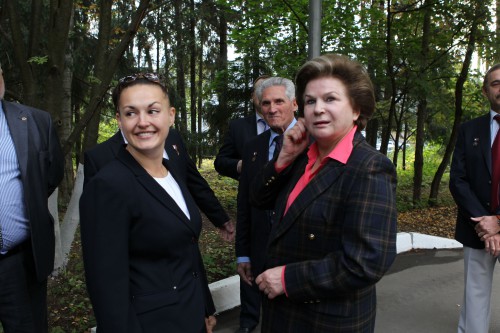
Born on 22 April 1976 in Vozdvizhenka, within the Ussurijsk region of Russia’s far-eastern Primorsky Krai, centered on Vladivostok, Serova grew up with a military father. “He used to take me to the airfield, where I could feel the atmosphere of the military, of the air force,” she recalled in a NASA interview. “I could feel everything that was related to flight and missions. The next step was the starry sky and it was something that impressed me so much. All these were little steps of the ladder towards my decision.” At school, she took a keen interest in astronomy, read the works of Konstantin Tsiolkovsky and met her future husband, Mark Serov, whilst studying in the aerospace department of the Moscow Aviation Institute. She graduated as a test engineer in March 2001 and, two years later, qualified as an economist from Moscow State University. Her first move into the space program came with an engineering post at the Energia Rocket Space Corporation and at the Mission Control Centre in Moscow.
Interestingly, Mark Serov had been selected for cosmonaut training in June 2003—in the same group as Aleksandr Samokutyayev—but retired from the corps in January 2011, without making a spaceflight. Serova, on the other hand, entered the cosmonaut group in October 2006 and underwent two years of basic training, prior to being designated a Test Cosmonaut in June 2009 and assignment to Expedition 41/42 in early 2012.
Aside from acclimatizing with their new environment, Wilmore, Samokutyayev, and Serova are united in their desire to head for one of the ISS windows as soon as they arrive aboard the station. And one window—or, rather, windows—tops the list: the cupola, near the end of the Tranquility node. Reflecting on the fact that he had barely a matter of minutes of “free” time on STS-129 to gaze upon Earth, Wilmore said that he looks forward to sticking his nose into the cupola for at least two full orbits. The cupola had not yet arrived at the ISS when STS-129 flew, but Samokutyayev remembered it fondly as the first place he visited when he arrived in April 2011. The cosmonaut described it as akin to having a hatch in the roof of his car.
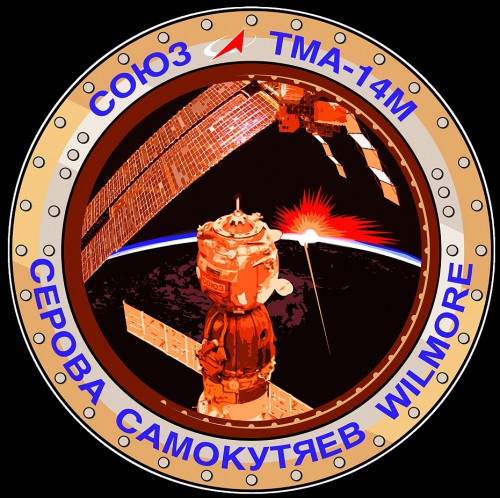
Indeed, one of the windows in the Zvezda service module—Window No. 9—factored into the Soyuz TMA-14M crew patch. This is one of 14 windows in Zvezda and is set into a flared “skirt” section between the main living and working compartments, but its 16-inch (41 cm) diameter makes it a popular spot for crew members to congregate. The patch shows an arriving Soyuz spacecraft, together with elements of the ISS structure, brilliantly lit by the reddish-orange glow of an orbital sunrise, as viewed through Window No. 9.
Assuming an on-time launch, Wilmore, Samokutyayev, and Serova will remain in orbit until 12 March 2015, when they will land back in Kazakhstan, after a 168-day mission. In addition to completing an outstanding job, all three were united in their desire to see the Home Planet from orbit. “I would like to see our Earth,” explained Samokutyayev, “because there is nothing more beautiful than looking at Earth from space and see the sunrises, the sunsets, the lightning strikes.” For Serova, her mission will be worthwhile for all of humanity. “We don’t do it for ourselves,” she said. “We do it for future generations, so that people on Earth live better, they have better opportunities, they have better conditions of life on Earth.” And for Wilmore, exploration and making new discoveries carries its own allure. “We honestly don’t know what we don’t know,” he said. “We have ideas about certain things and we point our noses in that direction, we point our efforts in that direction, we point our technology in that direction, we start trekking down that road, but many times we get steered off in a place that we didn’t even expect.”
Want to keep up-to-date with all things space? Be sure to “Like” AmericaSpace on Facebook and follow us on Twitter: @AmericaSpace
Missions » ISS » Soyuz TMA-M » TMA-14M »



